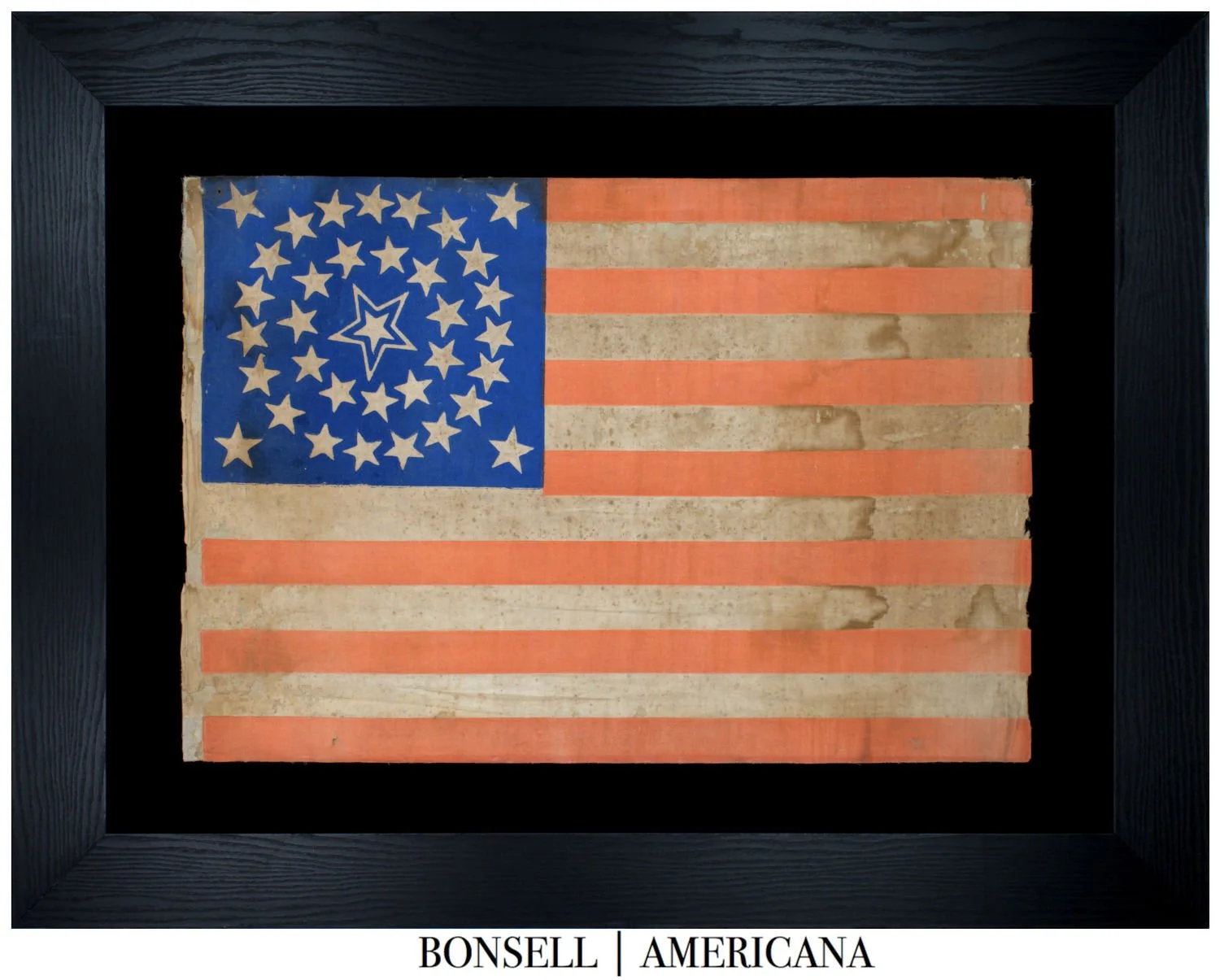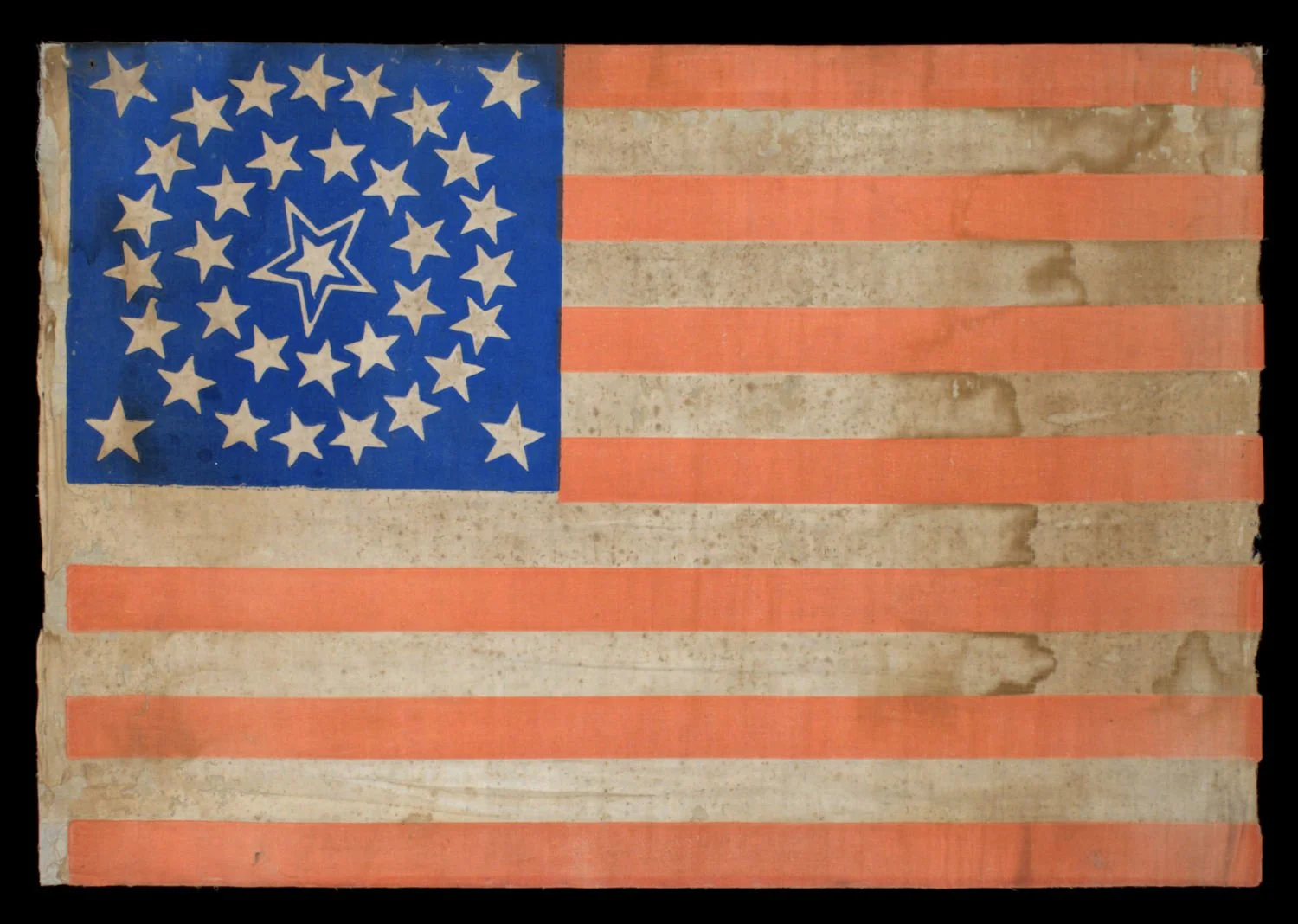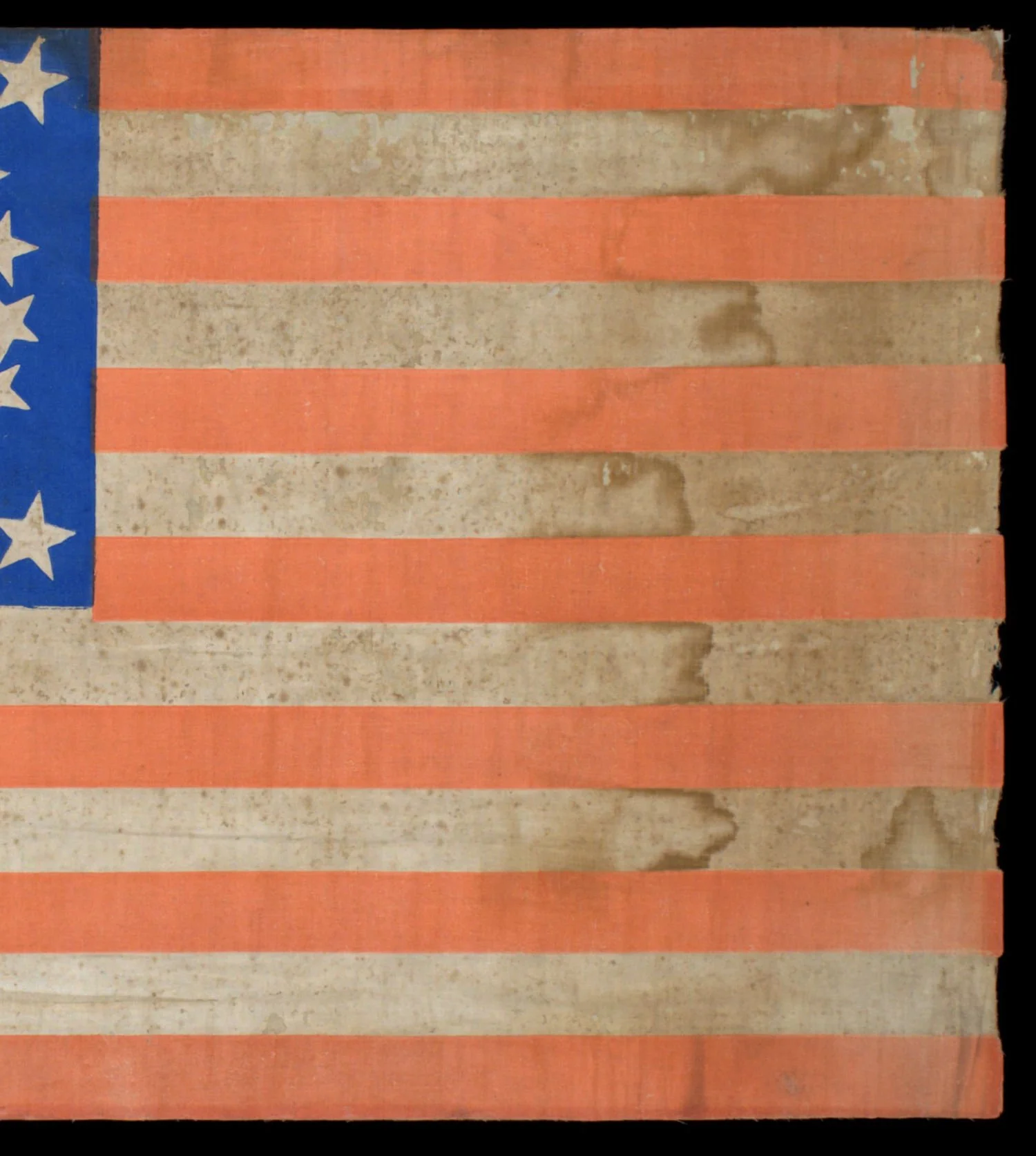Outstanding and Extremely Rare 36 Star Antique Flag with a Haloed Medallion | A Striking Flag from America’s Past | Nevada Statehood | Circa 1864-1867
Outstanding and Extremely Rare 36 Star Antique Flag with a Haloed Medallion | A Striking Flag from America’s Past | Nevada Statehood | Circa 1864-1867
Price: Call 618-553-2291, or email info@bonsellamericana.com
Frame Size (H x L): 30” x 39.5”
Flag Size (H x L): 19.5” x 28.5”
Offered is an extraordinary thirty-six star American flag, printed on coarse, glazed cotton. This striking example features a highly desirable medallion star pattern, a design that is both visually captivating and historically significant. At the heart of the canton lies a bold center star, encircled by two rings of stars, with additional flanking stars positioned in each corner—creating a stunning and meticulously balanced composition.
MEDALLION FLAGS: A REFLECTION OF AMERICAN PATRIOTISM AND ARTISTIC EXPRESSION
Medallion-patterned flags were a product of their time, appearing most frequently between 1861 and 1876. Unlike today’s standardized designs, nineteenth-century flag makers had the freedom to arrange the stars in any pattern they chose, resulting in highly creative and often elaborate designs. Among these, the medallion configuration was particularly prized, as it created a sense of order and symmetry while also making a bold visual statement.
Medallion flags were commonly used for patriotic displays, political rallies, and ceremonial occasions. They were typically printed on lightweight cotton or silk, making them more delicate than their wool bunting counterparts, which were more commonly used for military and naval applications. While many medallion-patterned flags were handmade or printed in small batches, their use declined by the late nineteenth century as industrialization led to mass production and increasing standardization. By the 1890s, most flag manufacturers had moved toward linear arrangements, a trend that was eventually codified in 1912 when President William Howard Taft issued Executive Order 1556, which mandated the arrangement of stars into rectilinear rows.
THE CENTER STAR: A SYMBOL OF GROWTH AND UNITY
One of the defining features of this flag is the large, canted center star—a hallmark of some of the most striking nineteenth-century flag designs. Unlike the Great Star pattern, in which a single large star is formed by smaller stars, the center star is a singular, prominent feature placed at the heart of the canton. Historically, the center star was often used to symbolize the most recently admitted state—in this case, Nevada.
Adding to the flag’s rarity, the center star is haloed, featuring a smaller, bold star enclosed within a faint outline. Haloed stars are highly collectible, as this unique design choice appears to have been the hallmark of a single, yet unidentified, manufacturer. This particular maker produced multiple haloed center star flags across different star counts, including examples with thirty, thirty-four, thirty-five, thirty-six, and forty-two stars.
THE DISTINCTIVE STRIPES
Another striking element of this flag is its orange-toned stripes. Instead of the deep crimson we associate with American flags today, the red stripes have taken on a distinctive orange hue. This variation is due to the natural dyes used during the period, primarily madder root and cochineal. Both dyes were commonly used between 1850 and 1880, and their hues could range from deep red to orange, depending on the concentration, mordant, and exposure to light over time. The warm patina of the stripes adds to the overall character of this piece, making it an even more compelling example of early American flag-making.
NEVADA’S PATH TO STATEHOOD
The thirty-six star flag represents the admission of Nevada into the Union on October 31st, 1864, in the midst of the Civil War. However, as was customary, the official adoption of the new star count took place the following July 4th, 1865. This flag was, therefore, the official banner of the United States for the last six months of the war and continued to be used throughout the early Reconstruction era.
Nevada’s road to statehood was both unique and deeply tied to national political and economic concerns. The region was originally part of the Utah Territory when it was established in 1850, but due to increasing tensions between Mormon settlers and non-Mormon mining communities, it was separated and designated as the Nevada Territory in 1861. However, despite its immense mineral wealth—particularly the Comstock Lode, one of the richest silver deposits in the world—Nevada had a small population and did not meet the typical requirements for statehood.
President Abraham Lincoln and congressional Republicans saw great strategic value in admitting Nevada as a state. Politically, Lincoln was seeking re-election in 1864 and needed additional electoral votes to secure victory against his Democratic opponent, General George McClellan. The addition of a Republican-leaning state to the Union would help bolster support for Lincoln’s administration and ensure continued backing for the war effort. Additionally, Nevada’s silver mining industry was crucial to the federal government, as the Civil War had placed enormous financial strain on the nation. The revenue from Nevada’s mines helped finance the Union’s war expenses, making the territory’s inclusion an economic necessity.
Statehood was fast-tracked, with Lincoln urging Nevada’s territorial leaders to draft a state constitution. In an unprecedented move, Nevada’s entire constitution was telegraphed to Washington, D.C., in October 1864, an act that was considered a remarkable technological feat at the time, as it was the longest telegraph transmission ever sent. Just days later, on October 31st, 1864, Lincoln signed the proclamation officially admitting Nevada as the thirty-sixth state.
Following its admission, Nevada’s borders expanded in 1866 when the western portion of Utah Territory was annexed to its eastern boundary. The following year, in 1867, another addition from Pah-Ute County, Arizona Territory, further extended the state’s southern region.
A FLAG THAT BRIDGES TWO ERAS
The thirty-six star flag is significant not only because of its association with the Civil War but also because it marks a transitional period in American history. It was the official flag at the close of the war, flown as Union forces achieved final victory over the Confederacy. It was also present during the beginning of Reconstruction, a complex and contentious era in which the nation grappled with reintegration and the rights of newly freed African Americans.
This flag remained the official U.S. flag until July 4th, 1867, when the thirty-seven star flag was introduced to commemorate Nebraska’s statehood. However, flags with thirty-six stars likely continued to be used well beyond their official tenure, as flag replacement was often slow, particularly in military and civilian contexts.
With its eye-catching medallion pattern, haloed center star, and unique orange-toned stripes, this flag stands out as an exceptional representation of American history. Whether displayed as a collector’s centerpiece, studied for its craftsmanship, or appreciated as a tangible connection to the Civil War and the Reconstruction era, this remarkable example encapsulates the artistry and patriotic fervor of the mid-nineteenth century.
Conservation Process: This flag was hand sewn to cotton fabric, and both were hand sewn to a mounting board. To prevent the black dye in the cotton fabric from seeping into the flag, it was first washed in a standard wash and then in a dye setting wash. The flag is positioned behind Optium Museum Acrylic.
Frame: The frame is a blend of contemporary and traditional styles, designed to bring the beauty of nature to any setting. Made in Italy and finished in an opaque black color, it adds a touch of elegance and sophistication to an office, home, or other environment.
Condition Report: This flag exhibits the expected wear and patina of a well-preserved mid-nineteenth-century textile. The cotton shows signs of age, with some staining and discoloration, particularly in the white stripes, which have developed a warm, aged tone. The canton retains strong coloration, though there is some fading and minor fraying along the edges. To enhance its presentation, cotton has been carefully placed behind certain portions of the flag to mask flaws and stabilize areas of wear.
Collectability Level: The Best – Perfect for Advanced Collectors
Date of Origin: 1864-1867
Number of Stars: 36
Associated War: Civil War (1861-1865)
Associated State: Nevada











